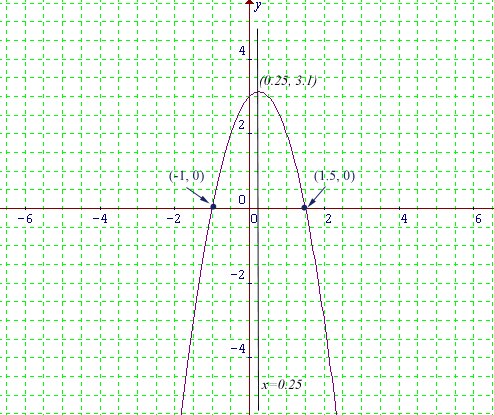Example 1:
Plot -2x2+x+
3, then find the turning point and the axis of symmetry from the graph.
When plotting a graph, the information below could be useful.
Use graph paper or grid
paper for accuracy.
Use X and Y as variables.
Give values to X and work out the
values of Y, set these values in a table.
Place the axes in the most
suitable position, to give the best presentation of the graph.
Label the axes.
Choose a suitable scale.
Plot the points from your
table of values.
Join the points to give a
smooth curve.
Let's make a table of values for y = -2x2+x+
3. Let's choose the x values between -2 and+2
| |
x |
-2 |
-1 |
0 |
1 |
2 |
| x × x |
x2 |
4 |
1 |
0 |
1 |
4 |
| Term1 (T1) |
-2x2 |
-8 |
-2 |
0 |
-2 |
-8 |
| Term2 (T2) |
x |
-2 |
-1 |
0 |
1 |
2 |
| Term3 (T3) |
+3 |
+3 |
+3 |
+3 |
+3 |
+3 |
| (T1)+(T2)+(T3) ,
y = |
-2x2
+ x + 3 |
-7 |
0 |
+3 |
+2 |
-3 |
This is the graph of y = -2x2+x+ 3

From the graph,
the axis of symmetry is x = 0.25, turning point is (0.25,3.1)
Example 2:
Sketch y = x2- 4x parabola.
Here are some useful hints for
sketching a graph.
Sketching a quadratic graph:
Graph paper or grid paper are not necessary.
The turning(where the parabola turns) points are important.
The y-intercepts(where the parabola cuts the vertical axis) are
important.
The x- intercepts(where the parabola cuts the horizontal axis)
are important.
Join the points to give a smooth curve.
Now, let's look at these parabolas.

Parabola (1) with two x-intercepts and a y-intercept
.
Parabola (2) with one x-intercept and a y-intercept .
Parabola (3) with no x-intercepts but there is a y-intercept .
Let's sketch y = x2-
4x,
First, let's find the intercepts.
To find the y-intercept, substitute x = 0 in y = x2- 4x, when x=0
, y =0
To find the x-intercept,
substitute y = 0 in y = x2-
4x,
x2- 4x = 0 , we can factorise the equation.
x ( x - 4 ) = 0
x = 0 or x - 4 = 0
x = 0 or x = 4
The graph passes through (0,0) and (0,4). The axis of symmetry should be halfway between
them.

So, the axis of symmetry is x = 2,
To find the turning point substitute x = 2 to the
expression and find the value of y
.
y = x2- 4x
when x = 2, y = 4 - 4×2 = 4 - 8 = - 4
The turning point is (2, - 4)
Now we can sketch the graph.
This is the graph of y
= x2- 4x

|